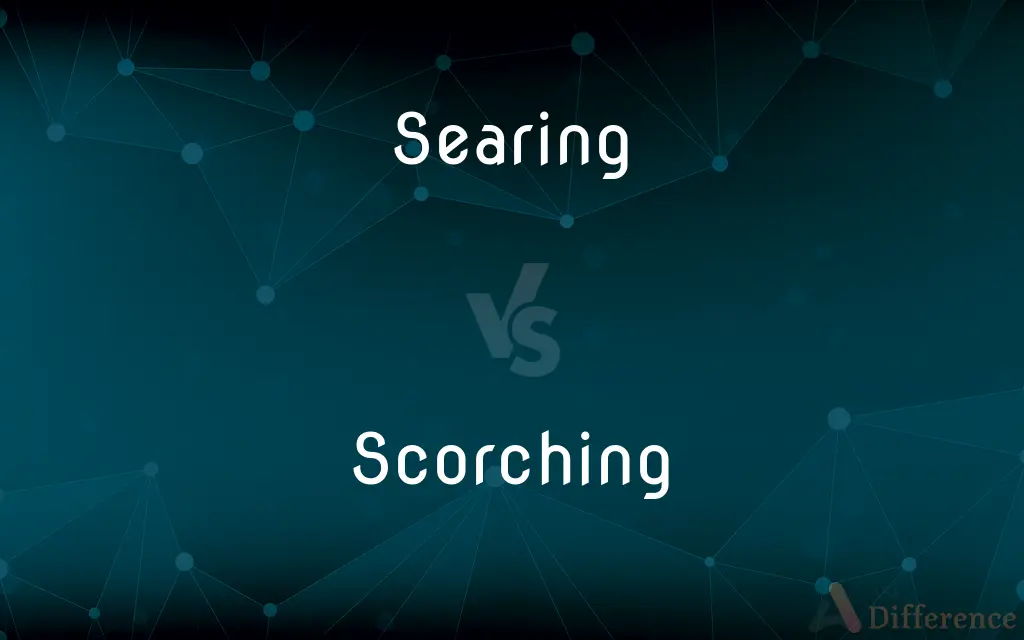Searing vs. Scorching — What's the Difference?
By Maham Liaqat & Urooj Arif — Updated on March 19, 2024
Searing involves applying intense heat to the surface of food to lock in juices, while scorching implies burning or damaging due to excessive heat, often affecting taste and texture negatively.

Difference Between Searing and Scorching
Table of Contents
ADVERTISEMENT
Key Differences
Searing is a cooking technique used primarily to lock in the juices of meat by quickly browning it at a high temperature. It creates a caramelized crust that enhances flavor. On the other hand, scorching usually refers to burning or damaging something with extreme heat. This can occur in cooking when food is left too long on a hot surface, leading to an undesirable taste and appearance.
While searing is often a deliberate step in the cooking process, aiming to improve the dish's flavor and texture, scorching is typically accidental. It results from excessive heat application or neglect, leading to a ruined dish. Whereas searing adds a rich, complex flavor, scorching can impart a bitter, charred taste that is generally considered unpleasant.
In searing, the goal is to quickly cook the outer surface of the food without cooking it all the way through, preserving the interior's moisture and tenderness. Scorching, however, often results in an overly dry, tough texture because the food's exterior and potentially its interior are exposed to too much heat for too long.
The equipment and settings for searing are crucial; it requires a pan that can handle high heat and a small amount of oil with a high smoke point. Conversely, scorching can happen with any cookware if the temperature control is neglected or if the food is not attended to properly.
In culinary contexts, searing is a technique celebrated for enhancing the dining experience by adding depth to the flavor profile of a dish. Scorching, on the other hand, is a mishap to avoid, as it detracts from the food's quality and can ruin the aesthetic appeal of a meal.
ADVERTISEMENT
Comparison Chart
Definition
Quickly browning the surface of food at high heat to lock in juices.
Burning or damaging something with excessive heat.
Intention
Deliberate culinary technique to enhance flavor and texture.
Often accidental, resulting from too much heat or neglect.
Outcome
Caramelized crust, enhanced flavor, preserved moisture.
Burnt, bitter taste, and potentially damaged texture.
Technique
High heat for a short time, using a pan with high smoke point oil.
Occurs with any cookware if left unattended or overheated.
Culinary Role
Celebrated for adding depth and complexity to dishes.
Considered a mishap, detracts from food's quality and appeal.
Compare with Definitions
Searing
Utilizes high heat for a short duration to enhance flavor.
Chefs recommend searing meat before roasting to improve taste.
Scorching
An undesired effect that ruins the dish's flavor and texture.
Avoid scorching by lowering the flame and using a timer.
Searing
Applying intense heat to the surface of food to create a caramelized crust.
Searing the steak on a hot pan locks in its juices.
Scorching
Burning food due to excessive heat, leading to damage.
Scorching the rice left it inedible and stuck to the pot.
Searing
Produces a rich, flavorful crust while keeping the interior moist.
The seared salmon had a crispy skin yet was tender inside.
Scorching
Involves careful heat control and attentiveness while cooking.
Constant stirring can prevent sauces from scorching.
Searing
A key step in many cooking processes for meats and vegetables.
Searing vegetables quickly retains their crunch and flavor.
Scorching
Usually results from neglect or improper heat management.
Forgetting the cookies in the oven led to them scorching.
Searing
Requires a pan that can sustain high temperatures and oil with a high smoke point.
I use a cast-iron skillet for searing meats.
Scorching
To burn superficially so as to discolor or damage the texture of.
Searing
Searing (or pan searing) is a technique used in grilling, baking, braising, roasting, sautéing, etc., in which the surface of the food (usually meat: beef, poultry, pork, seafood) is cooked at high temperature until a browned crust forms. Similar techniques, browning and blackening, are typically used to sear all sides of a particular piece of meat, fish, poultry, etc.
Scorching
Very hot.
It was a scorching summer, and the ice-cream sellers plied a roaring trade.
Searing
To char, scorch, or burn the surface of.
Scorching
Bitterly sarcastic; scathing; withering.
Searing
To brown (meat) quickly using very high heat.
Scorching
(Of speed when driving, running, etc.) very high.
Searing
Very hot; blistering or boiling
Scorching
Present participle of scorch
Searing
(of a pain) having a sensation of intense sudden heat
Scorching
The act or result of something being scorched.
Searing
Damning; critical; scathing
Scorching
Burning; parching or shriveling with heat.
Searing
Action of the verb to sear
Scorching
Sufficiently hot to cause scorching.
Searing
Cooking food quickly at high temperature
Scorching
Hot and dry enough to burn or parch a surface;
Scorching heat
Searing
Present participle of sear
Scorching
Capable of causing burns;
It was scorching hot
Common Curiosities
Can searing make meat dry?
Searing, when done correctly, does not make meat dry but locks in its juices, preserving its tenderness and moisture.
What is searing?
Searing is a cooking technique where food is cooked at high heat for a short time to create a caramelized crust.
Is scorching ever a desired cooking outcome?
Scorching is typically not desired as it negatively affects the flavor, texture, and appearance of food.
How does searing affect the flavor of food?
Searing enhances the flavor of food by creating a caramelized crust that adds depth and complexity.
How do I prevent scorching while cooking?
Prevent scorching by using moderate heat, stirring frequently, and not leaving food unattended on the stove.
Can vegetables be seared?
Yes, vegetables can be seared to enhance their flavor and retain a crisp texture.
What's the difference between searing and grilling?
Searing is done on a hot pan to create a crust, while grilling involves cooking food over direct heat on a grill.
How can I tell if I've scorched my food?
Scorched food has a burnt appearance and a bitter, unpleasant taste.
What does scorching mean in cooking?
Scorching in cooking refers to burning food due to excessive heat, often leading to a bitter taste and damaged texture.
Is searing necessary for all meats?
While not necessary for all meats, searing is often recommended for improving flavor and texture, especially for steaks and roasts.
What oil should I use for searing?
Use oils with a high smoke point, like avocado or canola oil, for searing to avoid burning.
How does scorching affect the nutritional value of food?
Scorching can destroy some nutrients and create harmful compounds, reducing the food's nutritional value.
What's the best pan for searing meat?
Cast-iron and stainless steel pans are ideal for searing meat due to their ability to withstand high heat.
Why does my food keep scorching?
Food may scorch due to high heat, insufficient stirring, or leaving it unattended for too long.
Can searing be done in an oven?
Searing is typically done on a stovetop, but a very hot oven or broiler can also create a similar effect.
Share Your Discovery

Previous Comparison
Lethargic vs. Drowsy
Next Comparison
Cricket vs. HockeyAuthor Spotlight
Written by
Maham LiaqatCo-written by
Urooj ArifUrooj is a skilled content writer at Ask Difference, known for her exceptional ability to simplify complex topics into engaging and informative content. With a passion for research and a flair for clear, concise writing, she consistently delivers articles that resonate with our diverse audience.
















































